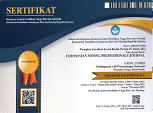Analysis of Carbon Monoxide Gas Dilution on Horizontal Tunnel Front using Laboratory Scale Physical Model
Abstract
Potential hazards that often occur in underground tunnels are dangerous and toxic gases, one of which is carbon monoxide (CO) which can be found in underground tunnels for example as a result of imperfect detonation on work surfaces. CO gas is very poisonous so it can cause death. This study aims to determine the spread of CO gas when diluting with tunnel ventilation in the horizontal front. This research was conducted on a physical model of the laboratory with a ratio of 1:10 compared to the actual tunnel, that is at the cross section of the model in the laboratory 40 cm x 40 cm. The effectiveness of dilution or dilution is indicated by the value of the diffusion coefficient, where the greater the diffusion coefficient, the more diffused the CO gas concentration, so the faster the CO gas concentration decreases. The parameters of the test conditions are the ratio of the duct to face distance (L/D) and the Reynolds number (Re) which shows the variation of air velocity in the tunnel work surface. Test results from the distribution of CO gas showed the influence of the configuration of the forcing duct and exhausting duct distances on the working front to the CO gas dilution. In this study also found the influence of Reynolds numbers on the value of the diffusion coefficient, that the greater the value of Re, the greater the value of E.
Keywords
Full Text:
PDFReferences
Hartman, H.L., Mutmansky, J., Ramani, R., Wang, Y.J. 1997. Mine Ventilation and Air Conditioning. New York: John Wiley & Sons, Inc.
McPherson, M.J. 1993. Subsurface Ventilation and Environmental Engineering. London: Chapman & Hall
Purawijaya, J.A. 2017. Analisis Dilusi Gas Karbon Monoksida di Developing Front pada Raise Vertical-Inclined Jalur Lurus Skala Laboratorium. Tugas Akhir Program Studi Teknik Perterowonganan Institut Teknologi Bandung.
Prockop, L. D., & Chichkova, R. I. (2007). Carbon monoxide intoxication: an updated review. Journal of the neurological sciences, 262(1-2), 122-130.
Saragih, Rogate. 2009. Penentuan Nilai Koefisien Difusi Gas Karbon Monoksida (CO) pada Simulasi Kebakaran Terowongan di Laboratorium. Bandung: Institut Teknologi Bandung.
Stewart, C.M. 2014. Practical Prediction of Blast Fume Clearance and Workplace Re-Entry Times in development Headings. South Africa: The Mine Ventilation Society of South Africa.10th International Mine Ventilation Congress 2014.
Strang, J., Wood, P.M. 1985. A Manual on Mines Rescue, Safety and Gas Detection. Australia: Weston & Co.
Sulistianto, Budi. 2015. Diktat Kuliah Sistem Penambangan. Bandung: Institut Teknologi Bandung.
Widodo, N.P., K Sasaki, R.S. Gautama & Risono. 2008. Mine Ventilation Measurement with Tracer Gas method and Evaluations of Turbulent Diffusion Coefficient. International Journal of Mining, Reclamation and Environment.
DOI: https://doi.org/10.36986/impj.v1i1.10
 views : 776
views : 776
Refbacks
- There are currently no refbacks.

This work is licensed under a Creative Commons Attribution-NonCommercial-ShareAlike 4.0 International License.


.png)


.png)









